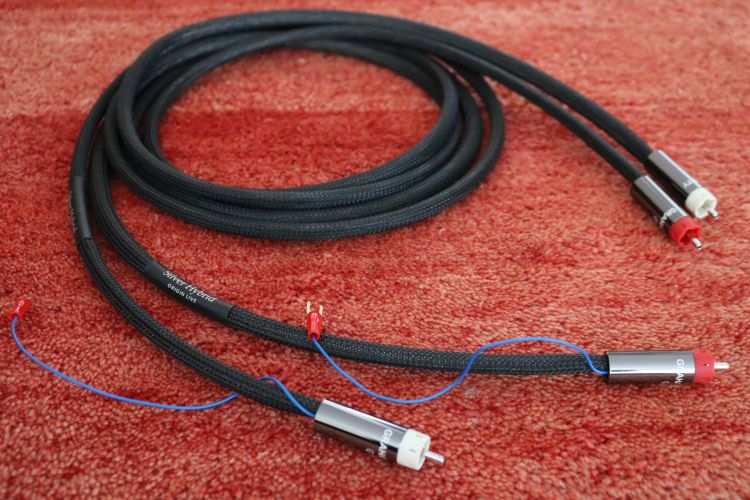
Review sample supplied by Origin Live
Retail prices:
Silver Hybrid cinch-cinch interlink 1-meter: £535.00 euro
Silver Hybrid cinch-cinch interlink 2-meter: £735.00 euro (as reviewed)
Other lengths also available
My system already contains an Origin Live Silver Hybrid cable in the shape as a tonearm cable but, so far, I was using a different cable between the phono stage and preamp. The Silver Hybrid cinch-cinch version will now extend the Origin Live spirit through the phono stage all the way to the preamplifier.
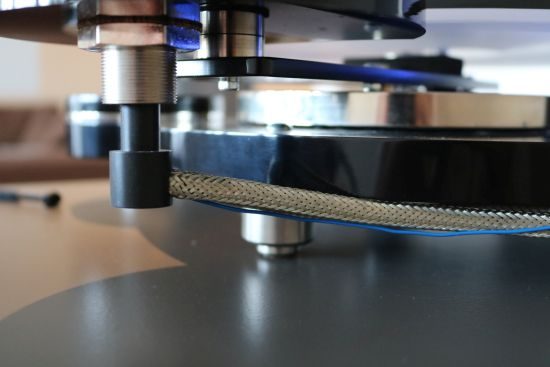
Above and below: Silver Hybrid tonearm cable
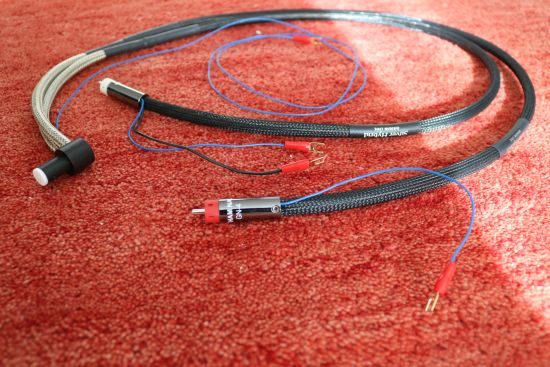
The Silver Hybrid design is the culmination of over 30 years of experience. It comprises Silver wires and Copper Litz wires laid up in an advanced configuration using little known handbuilt techniques. The wires are specially treated and receive cryogenic freezing. The highest performing Graham Nalty (Black Rhodium) GN4 single point contact plugs are fitted for minimal eddy currents. The cable has a pleasant thickness to it but is also very flexible. The connectors slide on smoothly but also seem to make for a tight fit. The cable’s shield is connected only to the two blue cable extensions on the one end meaning that the user can decide to use it or not.
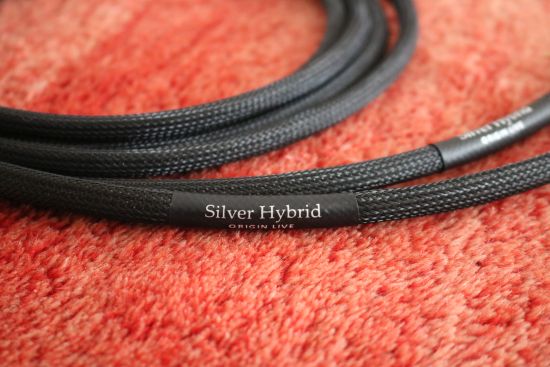
Before I dive into the listening session, let me explain a little about how the digital and analog parts of my setup became intertwined, because my setup is admittedly a little unusual.
Analog Setup – recent history
For the longest time, my analog section consisted of an ever-changing collection of Thorens spinners and was only used on the side. That is until I heard the Origin Live Calypso mk4. This magnificently musical yet undeniably technically superior turntable turned things around for me. After having played a couple of records I already knew that it was going to be a keeper. At this time, I had several entry-level phono stages as well as the pretty good Benz Lukaschek PP-1 on eternal loan from audio buddy JW. The PP-1 clearly already made the Calypso turntable sing but having owned a Jeff Rowland Cadence and a Pass X-Ono and having reviewed the Pass XP-17, I knew that it could be bettered.
The analog preamplifier that has stuck with me ever since I reviewed it is the Ayon Stealth which is actually a DAC with a tube preamp or a tube preamp with a DAC, depending on how you want to look at it. Its signal path is pure analog when using the analog inputs and, indeed, from the very first moment that I used it for analog, I felt that it struck all the right chords. No matter in which system I used the Ayon or with what turntables, it never failed to produce emotional and super-engaging music. Meanwhile, my reference system revolves around a CH Precision C1 DAC and A1.5 power amp, connected directly and so, for digital sources, I do not need an analog preamp.
Late 2019, when my budget allowed the purchase of one new reference-level audio component, I was faced with the decision between an analog preamp or a phono stage. Sure, now that I had the Origin Live turntable and analog had become a major part of my musical diet, an analog preamp made sense. But on the other hand, I already had the Ayon which performed superbly. Rather, the weakest link in my system at this point was the phono stage. After having reviewed the CH Precision P1 phono stage and loving its sound and flexibility, I decided to purchase it and use it with the Ayon. Sure, the immense offset in retail price makes this seem like an odd pairing but it works extremely well for me. Now, when I want to change between analog and digital, I just swap the interlinks to the A1.5 power amp, CH Precision Balanced Link XLR for the digital section and Cardas Clear XLR for the analog section. And that brings us to the subject of this review: the interlink between the P1 phono stage and the Ayon Stealth preamp.
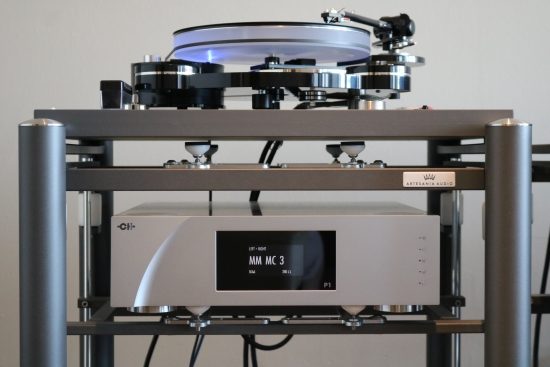
Current Setup
While XLR has historically been my preferred connection method, or rather, this was imposed by my choice of equipment (Jeff Rowland), I have nothing against single-ended cinch cables and I strongly feel that both can sound superb. It’s just a matter of finding the right cable and connection method for a given purpose. Ultimately, it’s all about the balance. My secondary Ayon/Xavian setup uses cinch cables exclusively and the ones that I found to repeatedly work well are the AudioQuest Water interlinks. As it happens, these cables also found their way into my main reference system where they also seemed to work very well and so, I never gave it a second thought. So, I had a 27.000-Euro CH P1 phono stage connected via a 700-Euro AudioQuest Water interlink feeding a 7000-Euro Ayon Stealth preamp. Talk about a strange combination. But, I promise, it worked! Of course, I knew from comparisons with some of my XLR cables that the Water was lacking resolution and treble air and probably a bit of flair, too, but it has lots of slam, great pacing and appealing tonality. Also, since the major part of my audiophile existence was littered with XLR cables, I simply had precious few cinch cable options, yet, the Ayon only has cinch inputs.
After having optimized my power spur with a GigaWatt circuit breaker and outlets and a Doepke Differential Switch, the sound of the digital section had much improved. For the analog section, however, the improvement only further highlighted the downsides of the system’s weakest link – the Water interlink.
While pondering alternatives for the AudioQuest cable, just recently, I realized that Origin Live also makes regular cinch cables. Knowing how great the Silver Hybrid sounded with the arm compared to the Origin Live “Upgrade” tonearm cabling, I wondered what would happen if I extended this cable also between phono stage and analog preamp. And with that, we have finally arrived at the listening part.
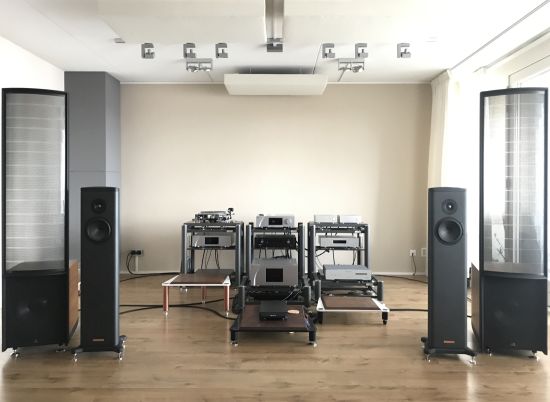
Listening
With a 3-man strong panel, we started listening to the existing setup using a couple of reference records. Dynamics, slam, sonorous tonality, check, check and check. But also lacking finesse and air and leaning toward dryness. Unless the record was produced to sound on the sweet and smooth side of neutral, the music could sound a little, well, digital, in the bad sense of the word.
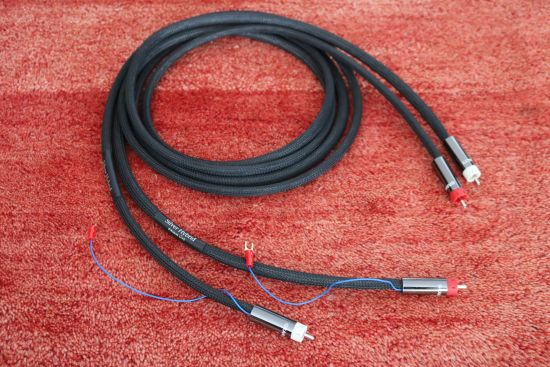
Out went the Water and in came the brand new Origin Live Silver Hybrid cinch interlink. Boy, this interlink turns things around! First, the treble with the Silver Hybrid is much airier and refined. It’s not at all silvery and certainly not hard, bright or edgy, as some (some will say many) silver-based designs can do but this cable sounds sweet, gentle and feathery but highly resolving, just as I like it from LP replay. The midrange is also a different story: sweet and lush but again with that sense of high resolution. Oftentimes, a sense of lushness comes along with an impairment in terms of liveliness or directness but here, so far, that did not apply. Also impressive is the cable’s soundstaging: far deeper and wider and with more of a sense of free-flowing liquidity to it while vocalists and instruments remained focused.
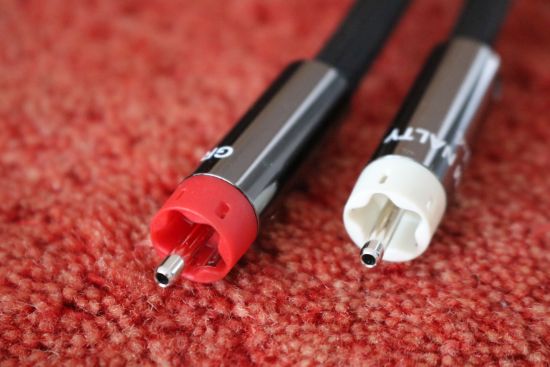
However, the pacing was a little slower and the bass quality was considerably less convincing. It lacked solidity and body and it was not nearly as incisive as that of the AudioQuest Water interlink. But then, the Origin Live cable was brand new and not run in at all. Rather than jump up to do something else as I normally do, we remained on the couch and played more records. To our surprise, the cable got better and better the more we played. Of course, I am not a stranger to the phenomenon of cable running in but usually, that is a process that can take days or weeks, not mere minutes. But here, I kid you not, every track sounded better than the last one, I kid you not. The bass got firmer and firmer while the pacing picked up and the midrange became ever more expressive, all while retaining its lush character. At around half an hour in, we all agreed that this cable should not be removed anymore! The only person in the group that had a slight reservation with a lingering hankering for the Water was me, the bass purist of the group. Even if the sound was now better and more involving in pretty much all aspects and the bass was full and well-proportioned, I felt that it could be slightly tighter and have slightly more attack. A change in the termination value on the L1 phono preamp did make for tighter bass but also diminished the cable’s free-flowing presentation, and with it, the sense of listening to analog. Then, the solution just popped up in my head.
As regular readers will know, I have had my share of adventures with the adjustments of the Illustrious tonearm. In a nutshell, it has three fixation points that all interact differently to various levels of tightness and, as I learned, it is important to tweak this carefully in order to achieve the best balance between attack and decay.
With that knowledge freshly installed in the working part of my conscience, I made two consecutive subtle adjustments to the tightness of the tonearm’s bottom nut which fixes it to the turntable’s arm board and presto: the sound landed in the sweet spot! JW and Wouter were completely happy with the midrange lushness and the absence of “digital” overt control while I was completely happy with the impact, tightness and propulsion of the bass. Wow, tweaks usually require counter-tweaks in other areas of the system but it’s seldom that a fundamental change is bedded in so quickly. Maybe I got lucky or maybe I’m just that good (cough!), either way, this was very clearly it. With the sound in the sweet spot, we played record after record for hours on end while landing from one amazement in the other. Now, the balance was always spot-on, no matter what we played. With the Silver Hybrid cable, super- “phat” and rich productions now have the loudness-like quality that they should have, leaner productions sound just like but are still involving while everything in-between also just falls into place.
100 hours
At this point, the cable has only had about 10 hours of playing time but every record that I spin, even with a cold system, immediately has that sense of rightness which makes me wonder what more the cable has in store once it has reached its recommended 100 hours of playing time.
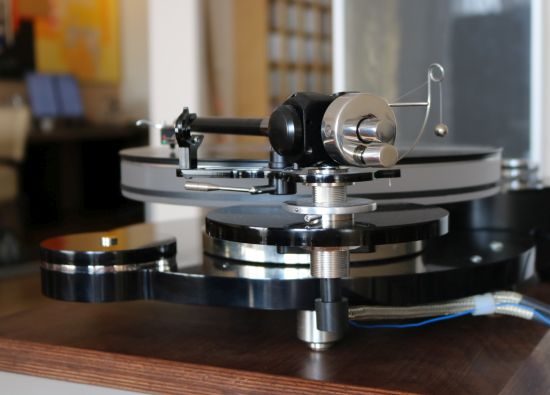
The VTA ring and horizontally-inserted hex screw, combined with the large nut underneath, are valuable tweaking tools!
Tonearm adjustments
The below is mostly of interest for those with an Origin Live turntable, or simply those interested in the precise adjustments that I made to re-balance the sound after the cable swap.
After having found the correct height using the VTA ring, the side hex-screw is fixed quite tightly, so that it just bites into the shaft but not any further. After that, the VTA ring can be loosened again. With the Silver Hybrid cable in place, the bottom nut can be tightened more than was pleasant with the AudioQuest Water, actually precisely as much as I can muster using only my thumb and index finger. If you’re then up for further experimentation, depending on the record or your mood, you could again tighten the VTA ring to varying degrees to adjust the balance between slightly laidback and slightly forward. However, based upon the reactions from several visitors, I suspect that most people will prefer the more relaxed sound with only the hex nut tightened and leaving the VTA ring loose.
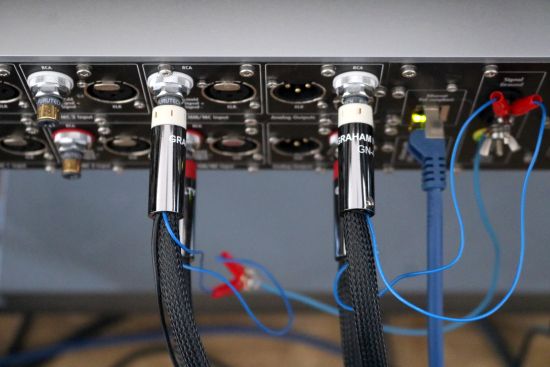
Two Silver Hybrid cables connected to the CH Precision L1 phono stage
While the Silver Hybrid is less obviously sonorous than the AudioQuest Water or the Vermouth Reference and slightly less tight and incisive as very clean-sounding cables such as the FoilFlex or CH Precision Balanced Link, the cable has a neutral and well-balanced sound. And even if it is highly refined, it is also not a cable that beautifies music at the cost of the overall transparency or precision, not with the ViRa Aidas Rainbow cartridge, in any event. This cartridge-tonearm-turntable combination positively sings using the Silver Hybrid tonearm and interlink. The music roars and surprises, it moves and involves and, importantly, it makes my foot tap.
Cable direction and Shield connection
The cable’s shield is not connected to the cinch plugs but is only connected only to the two blue cable extensions on the one end. This has the advantage that the user can decide to terminate the shielding or leave it floating. From experience, I know that there are audible differences between these methods.
Although many cable manufacturers claim to print their sleeves in the direction that the cable was produced, my understanding is that it is often not possible for a cable manufacturer to know this for certain unless they actually fabricated the source conductors. Still, it is sensible to choose one direction, run the cable in that way and keep using this direction. And what direction more appropriate than that indicated by an arrow or the logical reading direction of the text?
In the case of the Silver Hybrid cable, a direction is not specified but my instinct would be to use the cable in the direction that one reads the text on its label, with the source on the left and the destination on the right. Realizing that the shield is not connected to the cinch connectors’ earth, however, I am inclined to use the cable in the opposite direction since common knowledge dictates that RF noise should be diverted, as much as possible, away from the destination.
Upon checking with Mark Baker, he confirmed that this is the best approach indeed.
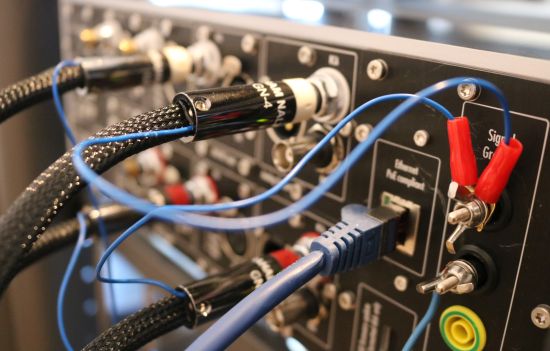
Shield connected independently, on the source end only
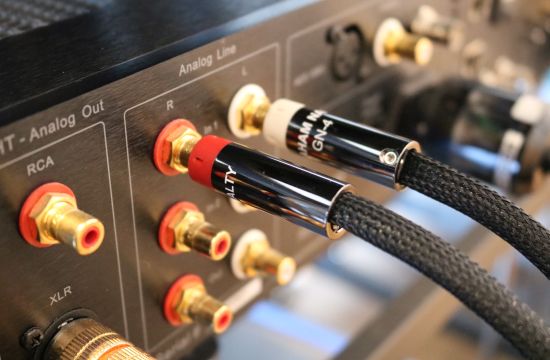
No shield connection on the preamplifier end
Shield connection sound differences
From the Silver Hybrid phono cable and its various earthing options I already knew that they all lead to a slightly different sound and so it made sense to expect the same from the cinch interlink. While the difference is not earth-shattering, it is audible. I should add that it is possible that the level of difference may depend on the amount of RF noise in a given environment and may again differ depending on the design of the phono stage.
In my case, the connection of the shield results in a slightly tighter delivery with subjectively faster bass and more open mids and lower treble. On the other hand, with the shield not connected, the delivery is more relaxed and slightly more forgiving in the upper midrange and lower treble. Personally, I prefer having the shield connected but I encourage everyone to just decide for themselves.
Conclusion
Clearly, Mark Baker knows what he is doing, not only in the field of turntables but also in the field of cables. I can’t praise this cable enough and perhaps the best part is that it costs approximately the same as the cable that it replaced. If ever there was a cable with an amazing cost/performance value, this is it.
While the Silver Hybrid cable majors on fluidity and free-flowing liquidity, it does not achieve this at the cost of precision, dynamics, neutrality or overall bass quality. It is also not a cable that beautifies music at the cost of transparency. With this cable, the Origin Live Calypso mk4 turntable positively sings. The music roars and surprises, it moves and involves. Not only does the music now sound more involving and emotional, but my inner bass lover is also entirely content. And now even more so than before, the turntable continues to make me wonder how much low-level detail is hidden in the grooves and, importantly, it makes my foot tap.
External Links
Manufacturer: Origin Live
Read Also
Origin Live Calypso mk4 with Multi-Layer Platter, Illustrious arm and Silver Hybrid cable
Origin Live Onyx tonearm
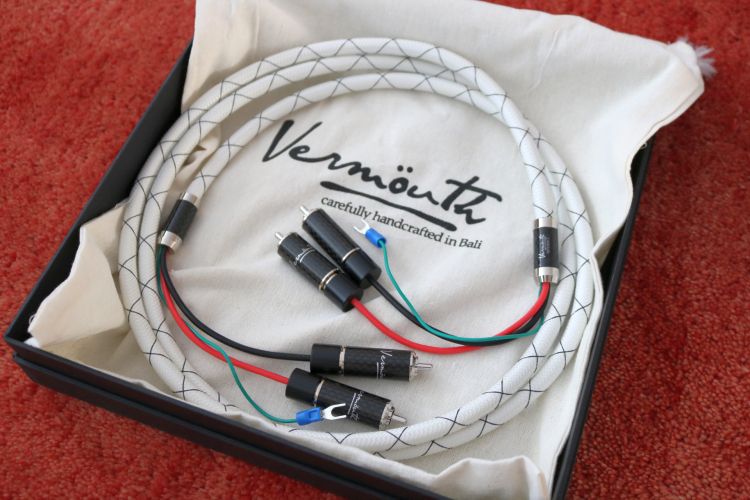
Secret building techniques. Wow.
Hi Christiaan,
Would you expect the same result if the interlinks were connected between a DAC and a preamp/integrated?
Thanks,
Mike
It all depends on the character of the components that you connect but I would say that the Silver Hybrid will always have a slightly lush and smoothly relaxed yet highly detailed and highly refined sound. In my case, the ViRa Aidas Rainbow cartridge is very articulate and precise and so is the P1 phono preamp. In this combination, the Silver Hybrid balances everything perfectly. If your source or downstream component are very lush sounding themselves, however, then maybe the Silver Hybrid would make a less ideal match.